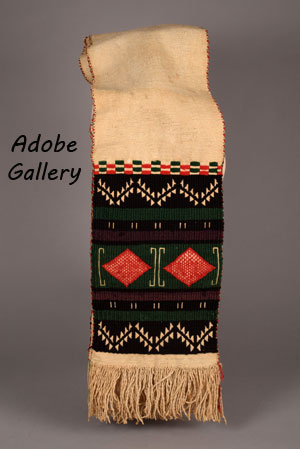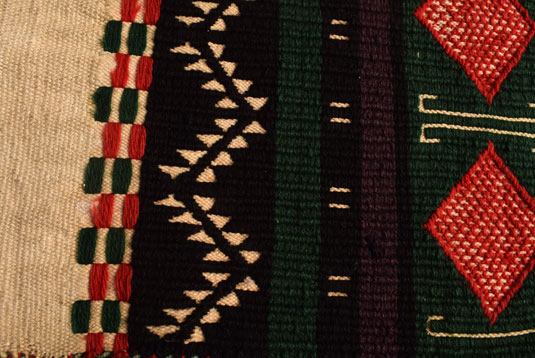Hopi Pueblo Cotton Brocaded Sash [SOLD]
+ Add to my watchlist Forward to Friend
- Category: Dance Paraphernalia
- Origin: Hopi Pueblo, Hopituh Shi-nu-mu
- Medium: cotton, wool
- Size: 96” long x 9” wide
- Item # C4552E SOLD
 This sash was woven in two sections, each measuring 48” x 9”, then they were lashed together with yarn. The sash was woven of cotton string, then the design panel was added with various colors of yarn. The white paired vertical lines represent a dragonfly, which is associated with water. The red diamond designs are flowers.
This sash was woven in two sections, each measuring 48” x 9”, then they were lashed together with yarn. The sash was woven of cotton string, then the design panel was added with various colors of yarn. The white paired vertical lines represent a dragonfly, which is associated with water. The red diamond designs are flowers.
The two ends have been elaborately patterned by a technique known as “Hopi brocade” although it is technically not true brocade. The name was assigned in 1938 by Frederic H. Douglas and has been retained since. According to Kate Peck Kent, it is a curious process and may be a Pueblo invention, unlike anything known from other cultures. According to one Hopi informant, young Hopi men are given a kilt, belt, and sash by their godfathers when they are initiated into manhood.
These wide sashes are often seen on dancers during Katsina dances at Hopi Pueblo. They have not changed in style appreciably since the late 1800s. James Stevenson collected an example in 1879 that is the same as those seen today. They are woven on a narrow upright loom in two identical pieces, each approximately 4 feet long and 10 inches wide. When completed, their undecorated upper ends are lashed together to make a long sash.
Rain is necessary for survival at the Hopi mesas. Anything a Hopi does is for rain. Katsina dances and Social dances are for rain. Rain can have a very personal role in a Hopi person’s life and identity. It can be part of a name, a clan affiliation, or a personal symbol. For example, potters and jewelers of the Water Clan sign their work with a rain cloud, a practice that began in the 1930s. Names such as Yellow Cloud and Frog Woman are tied to moisture and a good life. [Marshall, 2000:32]
Condition: evidence of having been worn
Provenance: this Hopi Pueblo Cotton Brocaded Sash is from the collection of a gentleman from California
Reference: Marshall, Ann. RAIN Native Expressions form the American Southwest

- Category: Dance Paraphernalia
- Origin: Hopi Pueblo, Hopituh Shi-nu-mu
- Medium: cotton, wool
- Size: 96” long x 9” wide
- Item # C4552E SOLD



